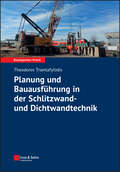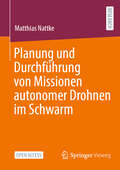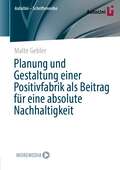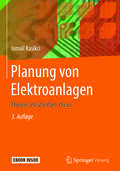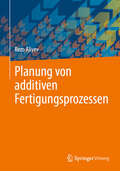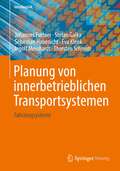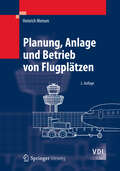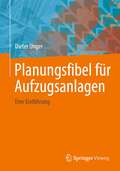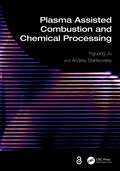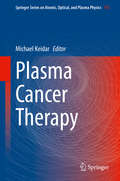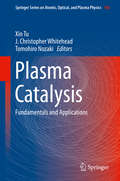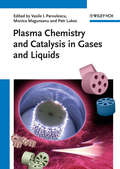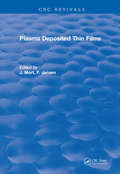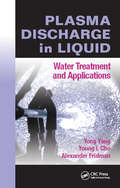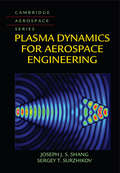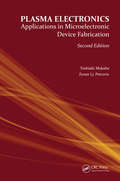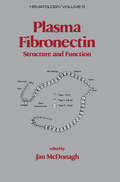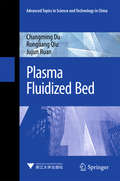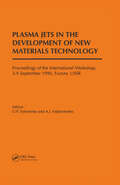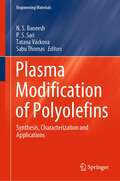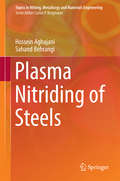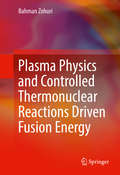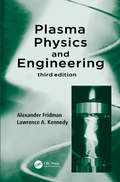- Table View
- List View
Planung und Bauausführung in der Schlitzwand- und Dichtwandtechnik (Bauingenieur-Praxis)
by Theodoros TriantafyllidisDas Buch behandelt die Verfahren der Schlitzwand- und Dichtwandtechnik und deren Anwendungsgrenzen sehr anschaulich. Es gibt praktische Anleitungen vom Entwurf bis zur Ausführung, auch von Neben- und Sonderleistungen. Darüber hinaus verrät es Lösungsansätze für schwierige Situationen, die durch weitläufig unbekannte oder unvorhergesehene Hindernisse entstehen. Für Ingenieure in der Planung und Bauausführung stellt das vorliegende Werk ein unverzichtbares aktuelles Praxishandbuch dar. Es gibt über den Stand der Technik hinaus wertvolle Hinweise für Möglichkeiten der Weiterentwicklung der beschriebenen Verfahren. Planung und Ausführung von Spezialtiefbauarbeiten liegen anders als früher heute nicht mehr in einer Hand; dem Planer fehlt die praktische Erfahrung und dem Ausführenden das Verständnis für die Probleme des Planers und teilweise auch die theoretischen Grundlagen. Dieses Buch will diese Lücke nicht füllen, sondern eher das Verständnis der Planenden und der potenziellen Auftraggeber für Probleme der Ausführungspraxis erweitern und ihnen näherbringen. Gleichzeitig spricht das Buch die Bauausführenden an und versucht, Probleme der Planung bzw. theoretische Grundlagen diesen Praktikern zu erläutern und mehr Sensibilität für die jeweiligen Bedürfnisse zu wecken. Die Lücke zwischen dem unterschiedlichen Verständnis von Planenden und Ausführenden sollte mit diesem Buch klarer und deutlicher werden, womit neue Wege der Qualitätssicherung gesucht und eingeschlagen werden.
Planung und Durchführung von Missionen autonomer Drohnen im Schwarm
by Matthias NattkeDieses Open-Access-Buch behandelt die Missionsplanung autonomer Drohnenschwärme als verteiltes System. Sie wird als vielseitiges Werkzeug verstanden, das beschreibende, gestaltende und anwendungsorientierte Aspekte umfasst. Die Weiterentwicklung des UAV-Sektors erfordert interdisziplinäre Ansätze, um Herausforderungen zu bewältigen und neue Anwendungsfelder zu erschließen. Ein umfassendes Verständnis von UAV-Systemen ist essenziell, um deren Entwicklung und Einsatz effizient zu gestalten. Technische Systemaspekte, konzeptionelle Flugplanungen sowie sicherheitsrelevante Interaktionen während der Mission werden berücksichtigt. Ein Fokus liegt auf der Analyse der Interaktion zwischen Maschine und Fernpilot. Diese Erkenntnisse fließen in die Entwicklung einer Prozessarchitektur ein, die Konzepte und Vorschläge bietet. Iterative Prozesse optimieren das kooperative Fliegen und die Flugstabilität der Drohnen. Das Ergebnis ist ein fliegendes Sensornetzwerk mit vielseitigen Anwendungen.
Planung und Gestaltung einer Positivfabrik als Beitrag für eine absolute Nachhaltigkeit (AutoUni – Schriftenreihe #162)
by Malte GeblerDas Konzept einer „Positivfabrik“ beschreibt die Vision, dass Fabriken und ihre Wertschöpfungsprozesse eine nachhaltige Entwicklung in der Biosphäre und in menschlichen Gesellschaften fördern. Positive Fabriken agieren daher als Impulsgeber für nachhaltige Lebensräume, indem sie Ökosysteme schützen, soziale Angebote bereitstellen und eine gemeinwohlorientierte wirtschaftliche Entwicklung unterstützen. Die Planung und Gestaltung einer Positivfabrik erfordert eine methodische und prozessuale Systematik, die der Autor strukturiert herleitet. Die inhaltliche Beschreibung des Prototyps einer Positivfabrik und die Konzeptanwendung verdeutlichen, wie eine Positivfabrik in der Praxis realisiert werden kann.
Planung von Elektroanlagen: Theorie, Vorschriften, Praxis
by Ismail KasikciDieses Werk stellt dem Planer von Elektroanlagen die benötigten technischen Grundlagen, die einzuhaltenden Vorschriften und Standards sowie vielerlei weitere praxisrelevante Informationen und Daten zur Verfügung. Nach Möglichkeit wurden die Planungswerte und Gleichungen in Tabellen und Abbildungen aufgeführt, um eine hohe Übersichtlichkeit und rasches Auffinden zu gewährleisten. Es dient somit als Lehr- und Handbuch für den täglichen Gebrauch durch den Elektro-Fachmann. Regenerative Energien insbesondere Wasserkraft,- Windkraft- und PV-Anlagen werden ebenfalls behandelt. Kurzschlussberechnung, Mittelspannungsanlagen, Erdungsanlagen, Spannungsfallberechnung und Schutztechnik bilden einen besonderen Schwerpunkt innerhalb des Werks. Viele Beispiele aus der Praxis runden das Buch ab.In der dritten Auflage wurden alle Themen sehr stark überarbeitet, besonders der Spannungsfall, Erdungsanlagen, Kurzschlussstromberechnung und Schutztechnik in HS-Anlagen. Das Buch wendet sich an Studierende der Elektrotechnik, Ingenieure, Techniker und Praktiker aus den Bereichen Nieder- und Mittelspannungsanlagen, Erdungsanlagen, Netzschutz, Planung, Betrieb und Instandhaltung, Netzbetreiber, Behörden sowie Ingenieurbüros.
Planung von additiven Fertigungsprozessen
by Rezo AliyevDieses Buch für die Planung von additiven Fertigungsprozessen stellt einen praxisorientierten methodischen Ansatz vor, der auf den wissenschaftlich fundierten Grundlagen der Planungsmethoden basiert. Die im Buch beschriebene Vorgehensweise unterstützt den Arbeitsplaner bei der Entscheidungsfindung in den jeweiligen Planungsphasen. Die für eine erfolgreiche Umsetzung der Planungsmethoden erforderlichen Kenntnisse werden werkstoffbezogen dargestellt, wobei sowohl die additive Fertigung metallischer als auch nichtmetallischer Werkstoffe abgedeckt wird. Dieses aus technischer und technologischer Sicht beschriebene Wissen führt den Arbeitsplaner sukzessive über mehrere Schritte zur Lösung der gestellten Fertigungsaufgabe.
Planung von innerbetrieblichen Transportsystemen: Fahrzeugsysteme (Intralogistik)
by Thorsten Schmidt Johannes Fottner Stefan Galka Sebastian Habenicht Eva Klenk Ingolf MeinhardtDieses Buch beschreibt bewährte, praxistaugliche Methoden zur Planung innerbetrieblicher Transportsysteme. Der Fokus liegt auf den wesentlichen Systemen und Förderfahrzeugen, die derzeit in der Industrie eingesetzt werden: Gabelstapler, fahrerlose Transportfahrzeuge, Routenzüge und Elektrohängebahnen. Neben einer Beschreibung relevanter Systemelemente und Gestaltungsmöglichkeiten liefert das Buch Empfehlungen zur Auswahl eines geeigneten Systems entsprechend der individuellen Anforderungen. Planungsschritte von der Erhebung von Plandaten bis zur Umsetzung werden vorgestellt. Methoden, die bei Planungsentscheidungen wie der Bestimmung der Anzahl benötigter Fahrzeuge helfen, sind detailliert beschrieben; ihre Anwendung wird anhand von Fallbeispielen demonstriert. Do's and Dont’s, basierend auf Erfahrungen von Praktikern und Wissenschaftlern, tragen dazu bei, Planungsfehler zu vermeiden.Das Buch wendet sich an Planer und Betreiber derartiger Systeme, Studierende einschlägiger Studienfächer bekommen einen vertieften Einblick in die Umsetzung der Methoden.
Planung, Anlage und Betrieb von Flugplätzen
by Heinrich MensenIn dem Handbuch für das Flughafenwesen werden sowohl die gesetzlichen Vorgaben zur Planung von Flugplätzen beschrieben als auch die beteiligten Organisationen und Verwaltungen. Die infrastrukturellen und abfertigungstechnischen Anforderungen werden von der Landseite, vom Terminalbereich sowie von der Luftseite her betrachtet. Die 2. Auflage enthält neue Kapitel zur Schließung von Flughäfen sowie zu ökologisch relevanten Fragen. Sie berücksichtigt aktuelle EASA-Klassifikationen und bietet viele Abbildungen und Karten von Verkehrsflughäfen.
Planung, Anlage und Betrieb von Flugplätzen (VDI-Buch)
by Heinrich MensenIn dem Handbuch für das Flughafenwesen werden sowohl die gesetzlichen Vorgaben zur Planung von Flugplätzen beschrieben als auch die beteiligten Organisationen und Verwaltungen. Die infrastrukturellen und abfertigungstechnischen Anforderungen werden von der Landseite, vom Terminalbereich sowie von der Luftseite her betrachtet. Die 2. Auflage enthält neue Kapitel zur Schließung von Flughäfen sowie zu ökologisch relevanten Fragen. Sie berücksichtigt aktuelle EASA-Klassifikationen und bietet viele Abbildungen und Karten von Verkehrsflughäfen.
Planungsfibel für Aufzugsanlagen: Eine Einführung
by Dieter UngerDie Planungsfibel soll für Architekten und Aufzugsplaner Hinweise geben, was bei der Planung einer Aufzugsanlage in einem Neubau, beim Bauen im Bestand und bei einer Modernisierung zu beachten ist. Die Fibel ersetzt keine Planung, sie soll aber als Hilfestellung dienen, Fehler zu vermeiden. Darüber hinaus soll durch Aufklärung einige im Markt vorhandene Missverständnisse beseitigt werden. Hierbei fließen meine eigenen Erfahrungen ein, die ich bei Planungsvorhaben in der Vergangenheit gewonnen habe.
Plasma Assisted Combustion and Chemical Processing
by Yiguang Ju Andrey StarikovskiyPlasma Assisted Combustion and Chemical Processing provides an introduction to the opportunities of plasma-assisted combustion and chemical processing for green energy conversion using renewable electricity.Covering the fundamentals of combustion and plasma physics and chemistry, it details the mechanisms and technologies of plasma-enhanced combustion, chemical process, materials manufacturing and recycling, and pollutant control. Addressing future challenges and opportunities of plasma-assisted combustion and electrified green manufacturing, this book covers the state-of-art methods of modeling and diagnostic tools to optimize the process design.This book offers graduate students and researchers a comprehensive review of the fundamentals and research frontier in this emergent field.
Plasma Cancer Therapy (Springer Series on Atomic, Optical, and Plasma Physics #115)
by Michael KeidarThis book, written by key researchers in the field, provides a comprehensive analysis and overview of the state of the art of plasma-based cancer therapy. Recent progress in atmospheric plasmas has led to non-thermal or cold atmospheric plasma (CAP) devices with ion temperatures close to room temperature. In contrast to many existing anti-cancer approaches, CAP is a selective anti-cancer modality which has demonstrated significant potential in cancer therapy.Written by a global, cross-disciplinary group of leading researchers, this book covers basic theory, generation, diagnostics, and simulation of cold atmospheric plasma, as well as their clinical application in cancer therapy, immunotherapy, and future outlook, giving a complete picture of the field.It is meant for a broad audience, from students to engineers and scientists, who are interested in the emerging world of plasma medical applications. It presents recent advances, primary challenges, and future directions of this exciting, cutting-edge field.
Plasma Catalysis: Fundamentals and Applications (Springer Series on Atomic, Optical, and Plasma Physics #106)
by Xin Tu J. Christopher Whitehead Tomohiro NozakiThis book provides a comprehensive overview of the field of plasma catalysis, regarded as a promising alternative to thermal processes for energy and environmental applications. It bridges the gap between the plasma and catalysis research communities, covering both the fundamentals of plasma catalysis and its application in environmental and energy research. The first section of the book offers a broad introduction to plasma catalysis, covering plasma-catalyst systems, interactions, and modeling. The core of the book then focuses on different applications, describing a wide range of plasma-catalytic processes in catalyst synthesis, environmental clean-up, greenhouse gas conversion and synthesis of materials for energy applications. Chapters cover topics ranging from removal of NOx and VOCs to conversion of methane, carbon dioxide and the reforming of ethanol and methanol.Written by a group of world-leading researchers active in the field, the book forms a valuable resource for scientists, engineers and students with different research backgrounds including plasma physics, plasma chemistry, catalysis, energy, environmental engineering, electrical engineering and material engineering.
Plasma Chemistry
by Alexander FridmanProviding a fundamental introduction to all aspects of modern plasma chemistry, this book describes mechanisms and kinetics of chemical processes in plasma, plasma statistics, thermodynamics, fluid mechanics and electrodynamics, as well as all major electric discharges applied in plasma chemistry. Fridman considers most of the major applications of plasma chemistry, from electronics to thermal coatings, from treatment of polymers to fuel conversion and hydrogen production and from plasma metallurgy to plasma medicine. It is helpful to engineers, scientists and students interested in plasma physics, plasma chemistry, plasma engineering and combustion, as well as chemical physics, lasers, energy systems and environmental control. The book contains an extensive database on plasma kinetics and thermodynamics and numerical formulas for practical calculations related to specific plasma-chemical processes and applications. Problems and concept questions are provided, helpful in courses related to plasma, lasers, combustion, chemical kinetics, statistics and thermodynamics, and high-temperature and high-energy fluid mechanics.
Plasma Chemistry and Catalysis in Gases and Liquids
by Petr Lukes Monica Magureanu Vasile I. ParvulescuFilling the gap for a book that covers not only plasma in gases but also in liquids, this is all set to become the standard reference for this topic. It provides a broad-based overview of plasma-chemical and plasmacatalytic processes generated by electrical discharges in gases, liquids and gas/liquid environments in both fundamental and applied aspects by focusing on their environmental and green applications and also taking into account their practical and economic viability. With the topics addressed by an international group of major experts, this is a must-have for scientists, engineers, students and postdoctoral researchers specializing in this field.
Plasma Deposited Thin Films
by J. Mort F. JansenIn Summary, the objective of this book is to present in one volume a review of the plasma deposition process and the present understanding of the most important and widely used plasma deposited thin film materials, devices and their applications.
Plasma Discharge in Liquid: Water Treatment and Applications
by Alexander Fridman Yong Yang Young I. ChoPlasma methods that effectively combine ultraviolet radiation, active chemicals, and high electric fields offer an alternative to conventional water treatment methods. However, knowledge of the electric breakdown of liquids has not kept pace with this increasing interest, mostly due to the complexity of phenomena related to the plasma breakdown process. Plasma Discharge in Liquid: Water Treatment and Applications provides engineers and scientists with a fundamental understanding of the physical and chemical phenomena associated with plasma discharges in liquids, particularly in water. It also examines state-of-the-art plasma-assisted water treatment technologies. The Physics & Applications of Underwater Plasma Discharges The first part of the book describes the physical mechanism of pulsed electric breakdown in water and other liquids. It looks at how plasma is generated in liquids and discusses the electronic and bubble mechanism theories for how the electric discharge in liquid is initiated. The second part of the book focuses on various water treatment applications, including: Decontamination of volatile organic compounds and remediation of contaminated water Microorganism sterilization and other biological applications Cooling water treatment Drawing extensively on recent research, this one-stop reference combines the physics and applications of electric breakdown in liquids in a single volume. It offers a valuable resource for scientists, engineers, and students interested in the topic of plasmas in liquids.
Plasma Dynamics for Aerospace Engineering (Cambridge Aerospace Series #43)
by Joseph Shang Sergey T SurzhikovThis valuable resource summarizes the past fifty years' basic research accomplishments in plasma dynamics for aerospace engineering, presenting these results in a comprehensive volume that will be an asset to any professional in the field. It offers a comprehensive review of the foundation of plasma dynamics while integrating the most recently developed modeling and simulation techniques with the theoretic physics, including the state-of-the-art numerical algorithms. Several first-ever demonstrations for innovations and incisive explanations for previously unexplained observations are included. All the necessary formulations for technical evaluation to engineering applications are derived from the first principle by statistic and quantum mechanics, and led to physics-based computational simulations for practical applications. The computer-aided procedures directly engage the reader to duplicate findings that are nearly impossible by using ground-based experimental facilities. Plasma Dynamics for Aerospace Engineering will allow readers to reach an incisive understanding of plasma physics.
Plasma Electronics: Applications in Microelectronic Device Fabrication
by Toshiaki Makabe Zoran Lj. PetrovicBeyond enabling new capabilities, plasma-based techniques, characterized by quantum radicals of feed gases, hold the potential to enhance and improve many processes and applications. Following in the tradition of its popular predecessor, Plasma Electronics, Second Edition: Applications in Microelectronic Device Fabrication explains the fundamental
Plasma Fibronectin: Structure and Functions
by Jan McdonaghThis volume deals with a multifunctional plasma and tissue protein, fibronectin, which participates in many significant biological and pathophysiological actions, presenting the information concerning structure and describing the interactions of fibronectin with fibrinogen and fibrin.
Plasma Fluidized Bed (Advanced Topics In Science And Technology In China Ser.)
by Changming Du Rongliang Qiu Jujun RuanThis book provides a detailed overview of the plasma fluidized bed. It is an innovative tool and generally combines plasma process with another efficient reactor, fluidized bed, providing an excellent method for particulate processes over conventional technology. The development and designs of typical types of plasma fluidized beds, mainly thermal plasma fluidized beds and non-thermal plasma fluidized beds are discussed. The influencing factors on the performance of plasma fluidized beds are analyzed in detail. The mechanism, i.e. the discharge characteristics, hydrodynamics, heat transfer and mass transfer are analyzed to offer a further insight of plasma fluidized beds. Applications of plasma fluidized beds for different areas, including metallurgy extraction, green energy process, environmental protection and advanced materials are presented. The book is a valuable reference for scientists, engineers and graduate students in chemical engineering and relative fields.
Plasma Jets in the Development of New Materials Technology: Proceedings of the International Workshop, Frunze, September 1990
by O. P. Solonenko A. I. FedorchenkoThe demands of industry for creating new functional materials with predetermined properties have stimulated an increasing interest in the investigation of processes occurring in plasma jets of complex chemical composition (homogeneous and heterogeneous) as well as their interaction with hard surfaces. This Proceedings volume contains contributions from leading international specialists on plasma science and technology which were presented at the 2nd International Workshop ''Plasma Jets in the Development in of New Materials Technology'', 3--9 September 1990, Frunze (USSR). The scope of the workshop incorporated the following aspects: modelling of the processes of momentum heat and mass transfer in homogeneous and heterogeneous plasma jets as well as interaction between the particles and the base; diagnostics of the parameters of gas and disperse phases in plasma flows; plasma-spraying processes investigations; processes of treatment and production of materials, including powder materials.
Plasma Modification of Polyolefins: Synthesis, Characterization and Applications (Engineering Materials)
by Sabu Thomas N. S. Baneesh P. S. Sari Tatana VackovaThis book addresses plasma modification of polyolefin surfaces. It comprises 21 chapters divided into three major sections. The first section covers the different techniques used for plasma modification of polyolefin surfaces and the effects of various gases as a surrounding medium, while the second provides a detailed analysis of the physics and chemistry of plasma modification and discusses various innovative characterization techniques, as well as ageing of the modified surface. It focuses on the analysis of changes in polymers’ surface chemistry using various spectroscopic techniques, and of changes in their surface morphology after plasma treatment using optical microscopy, electron microscopy and atomic force microscopy. In addition, it provides detailed information on the characterization of modified polymer surfaces. The book’s third and last section covers a range of applications of plasma-modified polyolefin surfaces varying from the packaging industry to the biomedical field, and shares valuable insights on the lifecycle analysis of plasma modification and modified surfaces.
Plasma Nitriding of Steels
by Hossein Aghajani Sahand BehrangiThis book focuses on the effect of plasma nitriding on the properties of steels. Parameters of different grades of steels are considered, such as structural and constructional steels, stainless steels and tools steels. The reader will find within the text an introduction to nitriding treatment, the basis of plasma and its roll in nitriding. The authors also address the advantages and disadvantages of plasma nitriding in comparison with other nitriding methods.
Plasma Physics and Controlled Thermonuclear Reactions Driven Fusion Energy
by Bahman ZohuriThis book covers the basic principles of both fusion and plasma physics, examining their combined application for driving controlled thermonuclear energy. The author begins by explaining the underlying scientific theory, and then goes on to explore the nuances of deployment within thermonuclear reactors. The potential for these technologies to help shape the new generation of clean energy is examined in-depth, encompassing perspectives both highlighting benefits, and warning of challenges associated with the nuclear fusion pathway. The associated computer code and numerical analysis are included in the book. No prior knowledge of plasma physics or fusion is required.
Plasma Physics and Engineering
by Alexander Fridman Lawrence A. KennedyPlasma Physics and Engineering presents basic and applied knowledge on modern plasma physics, plasma chemistry, and plasma engineering for senior undergraduate and graduate students as well as for scientists and engineers working in academia; research labs; and industry with plasmas, laser and, combustion systems. This is a unique book providing a clear fundamental introduction to all aspects of modern plasma science, describing all electric discharges applied today from vacuum to atmospheric pressure and higher, from thermal plasma sources to essentially cold non-equilibrium discharges. A solutions manual is available for adopting professors, which is helpful in relevant university courses. Provides a lucid introduction to virtually all aspects of modern plasma science and technology Contains an extensive database on plasma kinetics and thermodynamics Includes many helpful numerical formulas for practical calculations, as well as numerous problems and concepts This revised edition includes new material on atmospheric pressure discharges, micro discharges, and different types of discharges in liquids Prof. Alexander Fridman is Nyheim Chair Professor of Drexel University and Director of C. & J. Nyheim Plasma Institute. His research focuses on plasma approaches to biology and medicine, to material treatment, fuel conversion, and environmental control. Prof. Fridman has almost 50 years of plasma research in national laboratories and universities of Russia, France, and the United States. He has published 8 books, and received numerous honors for his work, including Stanley Kaplan Distinguished Professorship in Chemical Kinetics and Energy Systems, George Soros Distinguished Professorship in Physics, the State Prize of the USSR, Plasma Medicine Award, Kurchatov Prize, Reactive Plasma Award, and Plasma Chemistry Award. Prof. Lawrence A. Kennedy is Dean of Engineering Emeritus and Professor of Mechanical Engineering Emeritus at the University of Illinois at Chicago and Professor of Mechanical Engineering Emeritus at the Ohio State University. His research focuses on chemically reacting flows and plasma processes. He is the author of more than 300 archival publications and 2 books, the editor of three monographs and served as Editor–in-Chief of the International Journal of Experimental Methods in Thermal and Fluid Science. Professor Kennedy was the Ralph W. Kurtz Distinguished Professor of Mechanical Engineering at OSU and the Stanley Kaplan University Scholar in Plasma Physics at UIC. Prof. Kennedy is also the recipient of numerous awards such as the American Society of Mechanical Engineers Heat Transfer Memorial Award (2008), and the Ralph Coats Roe Award from ASEE (1993). He is a Fellow of the American Society of Mechanical Engineers, the American Physical Society, the American Institute of Aeronautics and Astronautics and the American Association for the Advancement of Science.
